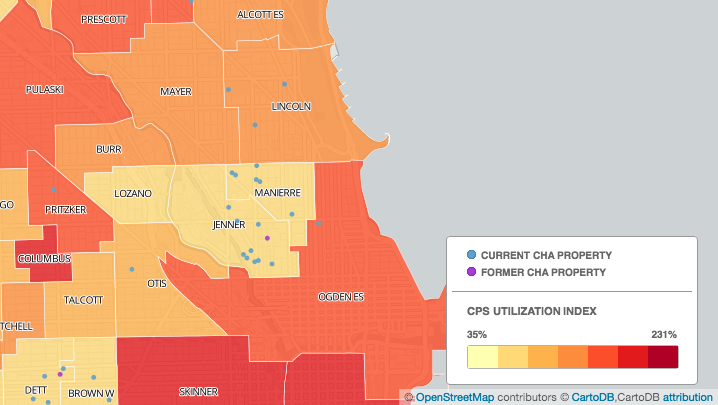WBEZ News
How Chicago School Construction Furthers Race and Class Segregation
Under Mayor Rahm Emanuel, Chicago Public Schools has spent millions on brand new schools and expensive additions, even in places where neighboring schools have plenty of space for extra students. This new construction is disproportionately going to schools that serve the white, middle class, sometimes ignoring opportunities to create more diverse schools.
What’s more, Emanuel plans to keep doing this, using revenue from a record property tax hike passed last year, documents obtained by WBEZ show.
Emanuel justifies this spending because the schools are overflowing with students and are short on space.
But there’s been little effort during his tenure to try to get these white, middle- and upper-middle-class students to attend one of the more than 300 Chicago schools that are deemed underused, even when those schools are nearby.
Most of the district’s underused schools serve poor, black and Latino students.
The result is that those under enrolled schools are kept racially and economically isolated and that’s not only expensive, it’s bad for children, says Richard Kahlenberg, an expert on economic integration who works for the bipartisan think tank The Century Foundation.
“We know that in trying to raise academic achievement, providing an economically integrated environment for students is far more powerful than spending extra resources in high poverty schools,” he adds.
Over the past six years, under Emanuel, the school district has spent $320 million on new school construction and is planning to spend another $330 million.
A WBEZ analysis of the $650 million in new school construction shows:
- $475 million or 73 percent of all money went to schools where white students make up more than a quarter of the student body. That’s in a school system in which only 12 percent of Chicago’s schools have more than 25 percent white students.
- Latino students are more likely to be in overcrowded schools, though they don’t get as much new construction. Seventy-five percent of the students in overcrowded schools in 2011-2012 were Latino, according to CPS data. But they make up half of the kids in schools that got new construction. Meanwhile, 18 percent of the students in overcrowded schools were white, but they make up 30 percent of kids in schools that got help with overcrowding.
- $224 million or more than one-third of the recent and proposed projects are intended to relieve overcrowding at schools sharing a border with a school that has space for additional students.
- $193 million is for magnet and selective high schools. Because of the way students are selected for top schools, they disproportionately serve white, middle-class families–a trend that has become more pronounced during Emanuel’s tenure, and since CPS was released from a court-order to desegregate its schools.
Through a spokeswoman, Emanuel declined to be interviewed for this story.
In an emailed statement late Wednesday addressing a new annex at one school and resources for another, the mayor’s office wrote, “the Mayor believes budgets are a reflection of our values, and in his budget speech last year, he made a clear commitment to invest in our schools. He’s following through on that commitment.”
New construction adds to district’s debt load
The cost of new construction is more than just the initial price tag. Most of the time, Chicago Public Schools and other districts borrow in order to pay for new additions or buildings. But Chicago’s bond rating is now in junk status, meaning the district and the city both get charged exorbitant rates.
The interest on just the school construction projects already done could be as much as $750 million, according to estimates in the district’s 2013 master facilities plan.
The school district could spend this capital money to repair and upgrade the schools it has. According to the district’s own most recent estimates, the city’s schools have more than $3.1 billion in needed repairs for things like lead abatement, leaky roofs and broken boilers.
According to the district’s master facilities plan, which was approved in 2013, building new facilities to deal with overcrowding is “extremely” expensive. In the plan, officials wrote that new school costs upward of $45 million, and each year for 30 years, the interest on a new school costs upward of $3.7 million. Meaning a new school that costs $45 million would actually cost $111 million over the life of the loan.
“To put this into context, an investment of that magnitude could fund 50 additional teachers for 30 years, to reduce our class sizes or provide new course offerings,” according to the master facilities plan.
The plan calls on the school district to look at boundary changes and to make sure that students outside of a school’s boundary are not attending the overcrowded school. It also says programs, such as gifted centers, should be moved from schools that are overcrowded before more building is considered.
For example, Skinner West, which is in line for a $20 million annex according to a list obtained by WBEZ, currently houses a classical program that draws students from all over the city. CPS data from last year shows more than 600 of the school’s 950-plus students came from outside of the neighborhood boundary.
But there’s no evidence that district officials have contemplated moving that program from Skinner to another nearby school. In fact, it’s unclear if any of the less expensive changes have been contemplated before announcing annexes and new schools. Most facility decisions are presented on a capital plan without much of an explanation.
CPS spokeswoman Emily Bittner reiterated that the list of capital projects obtained by WBEZ is preliminary and constantly changing. But she wouldn’t deny that certain projects were being considered.
“The district considers a number of options to determine what would be the best way to meet families’ needs,” she wrote in an email to WBEZ.
Construction further cements segregation by race and class
In some cases, the decision not to merge schools or redraw boundaries leaves poor black students in under-resourced schools just blocks away.
One example is Lincoln Elementary, where Emanuel and city officials recently unveiled a $19 million addition to the Lincoln Park school. Lincoln is in one of the wealthiest communities in the city and its students are 60 percent white and just 15 percent low-income. Lincoln is a mile and a half away from Manierre Elementary, but shares a boundary with the school. Manierre serves mostly children from public housing and is 96 percent black and 98 percent low-income.
Also in the area just north of downtown is Ogden International School of Chicago. Last year, parents and community members came up with an idea to merge with nearby Jenner Academy of the Arts, an under-enrolled school serving former Cabrini Green residents. The two schools’ local councils approved moving forward. But the district and the school board decided not to act. There is a renewed effort to explore a merger for the 2017-2018 school year.
See a fullscreen version of the CPS utilization map
Another example is Edwards Elementary in Archer Heights on the Southwest Side. It got a $22 million addition, but shares a border with Hearst Elementary. Hearst used to be the school serving LeClaire Courts, which were public housing row houses near Midway that have now given way to swaths of empty fields. Hearst has room for about 400 more students. Edwards Elementary is 96 percent Latino, while Hearst is about 35 percent black and the rest Latino.
Emanuel is planning to continue this trend. Among the plans outlined on the list obtained by WBEZ are two projects downtown. A $30 million new school in the South Loop at 16th and Dearborn and a $20 million addition at Skinner West in the West Loop. Both of these elementary schools share borders with elementary schools that have plenty of space now that public housing high rises nearby have been torn down.
District officials say the new South Loop school is needed because population projections show an additional 1,000 students will be living in the South Loop Elementary attendance zone by 2020. Late Wednesday, in announcing the Skinner West annex, officials also promised extra resources and a new STEM program for nearby Brown Elementary, which is under-enrolled and serves almost all black and all poor students.
The mayor and his hand-picked school board have already spent $110 million at Payton and Jones high schools. The preliminary list shows a plan to add a $20 million addition to Chicago High School for Agricultural Sciences for a seventh and an eighth grade. Also, Emanuel is moving forward with plans to build a $60 million selective high school on the Near North Side.
Since 2008, when the district was freed from a desegregation court order that set clear racial guidelines for selection, Payton, Jones and Chicago High School for Agricultural Sciences have become increasingly white and serve fewer low-income students.
Another one of the mayor’s ideas would be to add a $50 million junior high through high school on the Northwest Side that would likely go toward relieving crowding at Taft High School. Taft is half white and 50 percent low income. Yet, many of the high schools around it are seeing dwindling enrollment and could comfortably serve hundreds more students.
Dan Zimmerman, who resigned his post as principal of Foreman High School this Spring, says he has suggested to officials that they should move Taft’s boundaries and route more students to Foreman. With Foreman struggling to attract students, he doesn’t understand the hesitance.
Separate and Unequal?
Gary Orfield, director of the Civil Rights Project at UCLA, says the pattern WBEZ found sounds a lot like the 1960s.
“It goes way back in Chicago to ignore boundaries to preserve segregation,” Orfield says. He lived in Chicago when CPS was under a court order to desegregate its schools.
“Back in the initial civil rights era battles over school desegregation in Chicago, they built temporary classrooms – they called them Willis Wagons – on the black schools in order to avoid integration with the white schools that were half empty next door. And now, historically, it just gets flipped in the opposite direction, but it’s the same objective, or the same consequence, which is to preserve segregation.”
To Michael Persoon, a lawyer who represented parents in a lawsuit challenging the historic school closings in 2013, the reluctance to shift boundaries is an admission that the schools are not only separate, but unequal.
“When you look at CPS as being one unified school district, to me personally, it is a real problem, if you are saying that the quality of education in two neighborhood elementary schools is so different we would rather close that school than change the attendance boundaries,” he says.
CPS officials and parents cite school quality as a key factor in not redrawing boundaries. Schools that serve poor students generally have lower test scores than schools serving middle- and upper-middle-class students.
Orfield says it’s not unreasonable for parents to be concerned about academics and safety.
“Parents have the right to know the school is secure and the teachers have been trained and nothing’s going to be done to the quality of the instruction,” he says. “But they don’t have any right to preserve an enclave of privilege and they shouldn’t be fearful of coming in contact with poor kids. A lot of those kids’ parents have exactly the same values that the parents who are afraid of them have.”
An abundance of research has shown that middle- to upper-middle-class students come to school better prepared and once in school their parents are able to support them with extras like tutoring and academic-based summer programs that set them up for better attainment.
The district funds every school on how many students they enroll. Many of the most under-resourced schools are losing students because they are cutting programs. Fewer students means less money. Less money means fewer programs. Fewer programs means fewer students and so on.
Chicago also has several examples of local schools that have seen good results after more affluent parents enrolled their children in once faltering schools.
Ironically, South Loop Elementary is one of those examples. John Jacoby says he witnessed firsthand how integrating a school can make a difference for the students attending a racially isolated school. He says that then-CPS CEO Arne Duncan enticed him to send his daughter to a brand new gifted program being created at South Loop Elementary.
At first, it was a bit of a rocky experience and he had to balance the fears of his wife who thought their daughter might be safer at an established magnet school, like Andrew Jackson Language Academy.
In the end, it was a rewarding experience, he says. Not only did his daughter get a good education and land a spot at a selective enrollment high school, but the students that were there when the turnaround started also improved.
“To watch those kids grades rise along with everybody else’s and to have graduating classes within three years going to Kenwood, going to Lindblom,” Jacoby says, citing other high performing high schools, “I mean it proved to me…kids are not bad… there is nothing wrong with these kids if you provide the right culture and you provide the right supervision of the staff and you have a good principal who is going to strive for achievement. The kids will do it.”
But Jacoby says getting parents to buy into schools that are further south than South Loop is harder, considering all the reports of violence throughout the South Side.
CPS: ‘That’s part of the history of Chicago’
Jacoby says when he was on the Local School Council for South Loop, they tried to use part of National Teachers Academy on Cermak and State.
“There was such a revolt by scared parents,” he says. “They just thought that it was unsafe. I had mothers coming up to me saying, ‘How could you do this, John? Our children are going to be unsafe there.’ And we are talking about Cermak and State. There is such a perception.”
CPS Chief Education Officer Janice Jackson pushes back on the idea that the school district is turning its back on integrating schools. She says there’s little district officials can do and they are instead responding to a reality.
“It’s Pollyannaish to think that just because CPS steps in with a new policy that people are going to integrate,” she says. “The same families that you’re talking about that now live in these communities have choice.”
In other words, if Chicago Public Schools tried to shift boundaries or force families to go to different schools, they’d just leave to magnet schools, private schools or the suburbs.
“Trust me, if we thought we could relieve the (overcrowding) problem by simply assigning them to a different school, CPS would do that in a heartbeat,” Jackson says.
The threat that parents can leave CPS is the squeaky wheel “that gets the $20-million-dollar-annex oil,” says Mary Pattillo, a sociologist at Northwestern University.
She says the concern that families will leave if forced to integrate is problematic because only 8.9 percent of CPS students are white and that’s simply not enough to truly integrate the city’s schools.
But Pattillo says the mayor and city officials are pretty explicit about spending a disproportionate amount of scarce capital dollars on serving a small number of white, middle class families. It’s just less clear to the public that those decisions come at the expense of the mostly poor, black and Latino students in CPS.
Alderman Pat Dowell (3rd) has been working to get the new elementary school for the South Loop. But she also represents under-enrolled schools in Bronzeville, which is the neighborhood right next door.
“This is Chicago and you have to function within the city and I have to represent parents, a diverse group of parents,” Dowell says. “Right now, I have some priorities in terms of improving existing schools and solving the overcrowding at some others, but I am not taking on the entire issue of segregation, of income and segregation of races in the city of Chicago. It is not my role.”
CPS’s Janice Jackson says she doesn’t think it’s the district’s role either.
“That’s part of the history of Chicago,” she says. “I don’t think that’s a CPS issue.”
White, middle-class families are not the only ones demanding extra space. Latino parents also often go to Chicago Board of Education meetings asking for additions or new schools. Latino neighborhoods are often closer to black neighborhoods, but merging schools that serve black and Latino students has also proven to be difficult.
Laurence Msall, president of the fiscal watchdog Civic Federation, says he thinks Emanuel and school district officials understand the cost of their decisions.
“But what they do sometimes is make financially expensive decisions that are politically more attractive in the short term than they would be in the long term,” he says.










